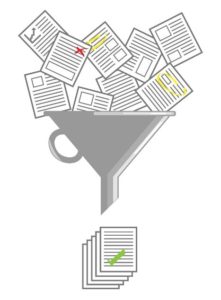
Adopting a new enterprise software tool can pose significant challenges, and given the timeline, there’s very little margin for error. You need things to go smoothly or risk not being ready to meet the compliance deadline.

Step 1.Choose lease accounting technology that fits your business processes and infrastructure
There are several lease accounting tools on the market, with more popping up all the time. Quick demos may give you the impression that they are all quite similar, but that can be misleading. One of the most critical factors is how well the system can adjust to the way you work and how it will fit into your technical infrastructure.
Your technology should conform to the way you work
Your lease accounting technology should adapt to the way you do things, rather than the other way around. It should be able to track different kinds of assets and group them the way you group them for operational purposes (e.g, by business unit, region, asset class, property or equipment type, rent type, master contract type, among others). You should be able to run reports in whatever order you want so that you can validate your work.
 When focusing on lease accounting standards, you should ensure that your system can accommodate things like different interest rates for varying asset types and lengths of terms. And whether you have a consultant helping you or not, the system should be flexible and easy enough to allow you to do this yourself, without having to involve the vendor or hire consultants every time you need something.
When focusing on lease accounting standards, you should ensure that your system can accommodate things like different interest rates for varying asset types and lengths of terms. And whether you have a consultant helping you or not, the system should be flexible and easy enough to allow you to do this yourself, without having to involve the vendor or hire consultants every time you need something.
It should seamlessly integrate with your existing systems
Every company has a unique technology infrastructure and there are many places that consume lease data, such as communication platforms, business intelligence tools, and ERP and AP systems. To minimize the complexity and implementation time, you’ll want your lease accounting system to plug into these systems without gaps. And when a vendor says it can integrate with your SAP or Oracle system, investigate the depth of the integration. Determine if the system provides flexible APIs, has XML data export/import capabilities, and whether it can create journal entries. Determine if it can integrate with multiple general ledgers. These features are needed for many integrations.
It should facilitate data migration and updating
Collecting and validating the data you’ll need for lease accounting calculations is a challenging part of FASB/IASB; getting it into your lease accounting database shouldn’t be. Check to see that the system vendor can migrate the data for you for a reasonable cost and within a reasonable time.
Also, as you live with your data, you undoubtedly will need to bulk update it from time to time. Check to see that the system has embedded import tools that are easy enough for you to use so that you don’t have to call on the vendor each time. Also check the scope of these import tools. Many only allow you to import limited data.
It should have built-in audit functions
The system you select should have features that ensure you end up with valid data in the system and accurate journal entries on your balance sheet. Look for data auditing features and alerts that let you know you may have data integrity issues. For example, if imported data fails to sync or assign, the system should let you know what happened and why so you can take corrective action.
Also, you’ll find that it’s extremely helpful to have flexible drill-down reporting capabilities that allow you to verify that the data in your FASB reports make sense from a business perspective. You should be able to run reports on the fly to investigate anomalies in your data.
Having the support or endorsement of one of the major accounting firms (and especially by your own advisory partners) will go a long way toward giving you the confidence that the system will perform accurately
2. Manage your stakeholders
Put together a cross-functional team to plan and execute your lease accounting software implementation. It’s essential that stakeholders are represented and involved early in the planning stage. The following departments need to be on the same page when preparing to implement a lease accounting software:
Real Estate: Your company’s most complex leases will be property leases. That’s why your Head of Real Estate and lease administrators will be invaluable allies in the process of locating, collecting, understanding and extracting the data you need for compliance with lease accounting standards. Ideally, when complete, your lease accounting system will become the single source of truth for all your lease information, even going so far as to use the system for payment processing. Relying on your lease administration system to pay landlords and other vendors is a great way to ensure the accuracy of your data.
Managers of equipment and fleet leases: Lease accounting standards require leased equipment to be included on the balance sheet. Chances are, your company doesn’t have a single group managing all those leases. So you’ll need to seek out and involve the various groups that do so they can help with data collection. For example, IT may be in charge of leasing computers, Procurement may manage office copiers, and Facilities may handle your vehicles.
Information Technology. Your IT team must validate that the technology you choose can integrate with existing systems as needed. IT will also need to be intimately involved in developing and implementing your data migration process.
Procurement. In many organizations, technology selection is coordinated by a procurement representative. Their expertise is valuable in thoroughly vetting vendors to ensure they meet organizational standards.
As you assemble your team, make sure roles are clearly defined and you designate an overall project leader as well as a point person for each key task.
3. Lock Down Your Policies
 You will need to make policy decisions that impact how data will be collected and used for calculations. Since your organization’s leases will vary in their structure and terms, you’ll need to develop rules to determine how different elements will be treated in your accounting calculations. Those decisions will guide you in forming both the Qualitative and Quantitative Disclosures in your financial statements.
You will need to make policy decisions that impact how data will be collected and used for calculations. Since your organization’s leases will vary in their structure and terms, you’ll need to develop rules to determine how different elements will be treated in your accounting calculations. Those decisions will guide you in forming both the Qualitative and Quantitative Disclosures in your financial statements.
4. Start Locating Your Data
As you begin to understand everything you’ll need to collect, the next step is to determine where that data currently lives.
 Property lease data may be the easiest to locate, since your real estate group is already tracking at least some of the data in spreadsheets or some form of lease administration tool. However, you’ll probably find that the data being tracked is not complete, and you’ll need to go back to the physical copies to get more details. Those documents are likely to be found in drawers and file cabinets throughout your organization. This is where you’ll need the help of your real estate team to track it all down.
Property lease data may be the easiest to locate, since your real estate group is already tracking at least some of the data in spreadsheets or some form of lease administration tool. However, you’ll probably find that the data being tracked is not complete, and you’ll need to go back to the physical copies to get more details. Those documents are likely to be found in drawers and file cabinets throughout your organization. This is where you’ll need the help of your real estate team to track it all down.
Other types of asset leases may be more difficult. Chances are, you won’t find it in any central location. You’ll need to extract it from various systems as well as hard copies.
Once you find the data you need, you must get it all into a common format that can be easily migrated. That involves abstracting the details from lease documents and centralizing all the data you collect so it’s ready for migration into your lease accounting system.
5. Decide what you are going to abstract and how
As you develop your implementation timeline and choose lease accounting technology, you must have a realistic plan for extracting the data from your lease documents.
Lease data categories
There are several buckets of data that are contained in your leases. Consider these questions in your analysis:
- General information – usually includes lease type, business unit to which it belongs, region, location, dates, parties. Do you know how else you would want to group records?
- Parties – this would normally include lessor, lessee, payor and payee. Should you include additional contacts such as brokers, operational contacts, accounting contacts?
- Documents – should you upload all legal and billing documents or just legal ones?
- Financial – you will need to track lease payments, of course. But you also have to manage your assumptions for capital lease testing, option period testing, FMV values, useful lives, etc. Keep all of this in mind when defining the scope of your abstracts.
- Legal clauses – your operational team (real estate, equipment) will want to track many more fields to support their work. These include things like facilities and maintenance obligations, legal rights, property attributes, option details, etc. Decide what you need and why, and then figure out how to get the answers.
Abstract once or abstract twice?
It takes 2 to 5 hours to read and summarize (abstract) the financial and real estate terms of a typical real estate lease and about 30-60 minutes for a simple equipment lease. Depending on your time pressure, you might want to just abstract the items that impact the lease accounting calculations and save the rest for later. This will cut the real estate lease time by about 40%, and the equipment lease time by about 15%.
However, you’ll get the full benefits of your lease technology sooner when you establish a single source of truth that contains all your validated lease information. Also, going back to fill in the missing information will take longer than had it been done at one time. Check with your stakeholders to see if this is an acceptable plan.
You may need as many as 200 data points to properly abstract a complex lease. Our lease experts have identified less than 20 minimum data points that many organizations will need to stay FASB-compliant. In our 30-minute Visual Lease demo, we share exactly what they are, how you can get them, and how Visual Lease uses them for rapid compliance with FASB and IASB rules. Book a demo now to see for yourself.
Artificial intelligence and lease abstracting
Some vendors will tell you that it’s fine to use artificial intelligence (AI) and other automated lease abstraction tools to speed up the abstracting process. Most true machine-learning/AI tools are not yet mature and will be very expensive for even a large company to implement.
Conversely, most of the tools on the market use simple OCR to extract easy-to-identify terms. Vendors tout 90 percent accuracy for automated tools, which may sound good until you realize that 10 percent of your data will be wrong. Finding the 10 percent could take up more time that the entire process saved.
You may want to consider a hybrid approach, using automated tools to extract monthly rent payments and other simple terms and leaving the more difficult abstracting cases to humans who understand the standards and work according to the recommendations of your accounting advisement partners. This streamlined process results in better data integrity while shrinking your timeline to compliance.
6. Validate your data
After you gather data from many different repositories, especially for large organizations with multiple subsidiaries, you’ll need a process for validating that the data is correct. For example, you might find the same information in multiple places, and need to figure out which to use as the source of record. You may need to consolidate and convert information in different languages and currencies. And you will certainly have holes where the information you’re looking for was never tracked. For example, for real estate leases you may need to find out the likelihood of lease options being exercised.
To validate and complete your database, you’ll need to turn to the SMEs in your organization who obtain and/or manage the leases. Make sure you build this process into your implementation timeline.
Conclusion: the right platform + smart preparation shorten your timeline to compliance
There are important considerations to be made when choosing a lease accounting software, like data security features, comparing price to value, and more. You don’t want to jump into a contract with a lease accounting software that isn’t compatible with your business. Once you’ve documented and substantiated your lease data, technology implementation should be fast and straightforward; in fact we’ve proven that can be done in 30-60 days. Let us show you how.
About Visual Lease
Visual Lease is a leading provider of lease accounting and lease administration software. Our software will help get your organization compliant with ASC 842 and IFRS 16 requirements. The Visual Lease platform also provides and easy-to-use Day 2 solution with its lease management capabilities and infrastructure. The system enables organizations to quickly and easily manage their lease portfolios, define and track specific lease clauses, proactively manage critical dates (such as renewal options), and visualize your asset portfolio! Request a demo of Visual Lease today























